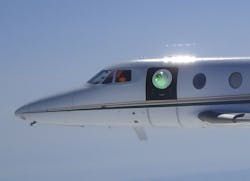Lockheed Martin tests laser tail gun technology to protect aircraft from enemy fighters and missiles
SUNNYVALE, Calif., 22 Sept. 2014. Aircraft laser weapons experts at the Lockheed Martin Corp. Space Systems segment in Sunnyvale, Calif., are conducting tests to validate the airworthiness of a prototype high-energy laser tail gun intended to protect combat aircraft from attacks from the rear.
Lockheed Martin has demonstrated the airworthiness of a beam-control turret being developed for the Aero-Adaptive/Aero-Optic Beam Control (ABC) program of the U.S. Defense Advanced Research Projects Agency (DARPA) in Arlington, Va., to give 360-degree coverage for high-energy laser weapons operating on military aircraft, company officials announced earlier this month.
A research aircraft equipped with the DARPA ABC-developed turret conducted eight flights in Michigan, in partnership with the U.S. Air Force Research Laboratory (AFRL) at Wright-Patterson Air Force Base, Ohio, and the University of Notre Dame in South Bend, Ind.
The ABC turret system is designed to enable high-energy lasers to engage enemy aircraft and missiles above, below, and behind the aircraft, Lockheed Martin officials say. Flow-control and optical-compensation technologies counteract the effects of turbulence caused by the protrusion of a turret from an aircraft’s fuselage.
All turret components meet U.S. Air Force and Federal Aviation Administration airworthiness requirements. Subsequent flight tests over the next year will demonstrate the turret in increasingly complex operations, Lockheed Martin officials say.
The company began developing the ABC laser turret early last year under terms of a $9.5 million contract modification from DARPA for the ABC program's third phase to improve the performance of high-energy lasers on tactical aircraft against enemy aircraft or missiles in the aft field of regard.
Related: Air Force eyes fuselage-mounted laser weapons to defend bombers from missiles and aircraft
It was this contract that called for Lockheed Martin flight test an active flow control turret mounted on a business jet to validate turret requirements, design, and predicted performance of ABC technology the company developed in the second phase of the program.
Lockheed Martin's work in the ABC program has included optimizing flow control for pointing angles behind tactical aircraft, as well as exploring how to synchronize ABC flow-control technology with adaptive optics.
Lockheed Martin engineers are designing representative optical paths, a scaled turret, and flow control actuator system, as well as conducting wind-tunnel testing, and mounting a prototype aircraft laser-defense weapon to the test aircraft -- the Airborne Aero Optical Laboratory Transonic Aircraft that belongs to the University of Notre Dame.
Related: Northrop Grumman, Lockheed Martin to develop pod-mounted aircraft and UAV laser defenses
Adaptive optics involves manipulating the shapes of lenses and mirrors to enable high-energy laser weapons to compensate for the effects of atmospheric turbulence.
Lockheed Martin is doing the work on the third phase of the ABC program in Sunnyvale, Calif.; Fort Worth, Texas; and Orlando, Fla. Company officials should be finished with the program's third phase by fall 2015.
For more information contact Lockheed Martin Space Systems online at www.lockheedmartin.com/us/ssc, or DARPA at www.darpa.mil.

